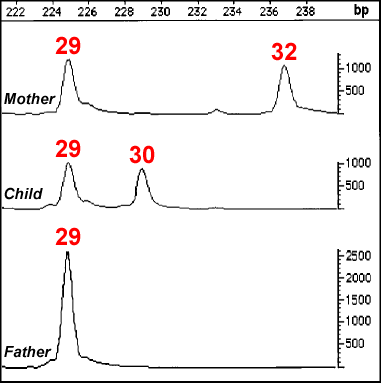Archival Notice
This is an archive page that is no longer being updated. It may contain outdated information and links may no longer function as originally intended.
Home | Glossary | Resources | Help | Contact Us | Course Map
Mutations occurring during meiosis can affect the interpretation of paternity tests. A mutation during meiosis may result in discrepant results at a locus. For instance, a mother has a 14, 15 type at D3S1358. The assumed biological father has a 17, 18 type at D3S1358. The offspring has a 15, 19 type. When data at this one locus are compared, it appears that the child's assumed biological father can be excluded because the male could not have passed the 19 allele on to the child. During meiosis it is possible for an additional tetranucleotide repeat to be added to the DNA strand. Therefore, the male could have passed along a 19 allele, even though he doesn't have that allele type, if this mutation takes place.
Since mutations occur at known rates,05 it is important to develop a procedure to effectively deal with them in paternity cases. Many researchers in the field suggest using a two locus exclusion for STR paternity testing.06 Since mutations are relatively rare for the core STR loci, it is unlikely that two mutations would occur during meiosis at two different loci.
Somatic mutations have been known to occur at STR loci used in forensic testing. A somatic mutation occurs within somatic cells and are not inherited.
For example, a somatic mutation can occur in early embryonic development within an STR locus. Although the embryo inherits an 8 allele at D7S820 from its mother and a 9 allele from its father, the mutation results in an additional 10 allele. Therefore, the child will exhibit a tri-allelic pattern at D7S820. A mutation of this type can look like a mixed DNA sample or a contamination event at that locus. After a review of data from other loci, these concerns can be dismissed. It might be advisable to retest the sample or possibly other tissue types from the individual to confirm the DNA profile.
A somatic mutation can occur after tissue differentiation begins in an embryo's development. In this case (for example), it is possible for the DNA profile obtained from a buccal swab to be different from that obtained from a hair or blood sample. If this mutation occurs early in the embryo's development, then it is more likely to be the common type throughout all of the tissues.
Additional Online Courses
- What Every First Responding Officer Should Know About DNA Evidence
- Collecting DNA Evidence at Property Crime Scenes
- DNA – A Prosecutor’s Practice Notebook
- Crime Scene and DNA Basics
- Laboratory Safety Programs
- DNA Amplification
- Population Genetics and Statistics
- Non-STR DNA Markers: SNPs, Y-STRs, LCN and mtDNA
- Firearms Examiner Training
- Forensic DNA Education for Law Enforcement Decisionmakers
- What Every Investigator and Evidence Technician Should Know About DNA Evidence
- Principles of Forensic DNA for Officers of the Court
- Law 101: Legal Guide for the Forensic Expert
- Laboratory Orientation and Testing of Body Fluids and Tissues
- DNA Extraction and Quantitation
- STR Data Analysis and Interpretation
- Communication Skills, Report Writing, and Courtroom Testimony
- Español for Law Enforcement
- Amplified DNA Product Separation for Forensic Analysts


